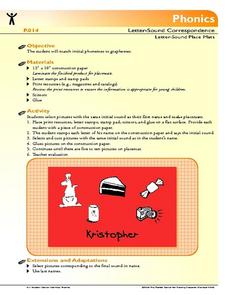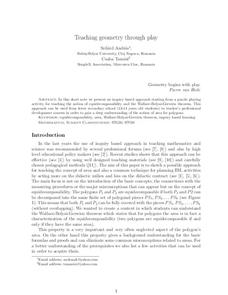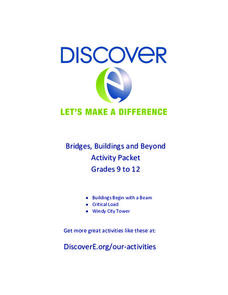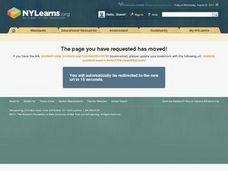Curated OER
Rooftop Gardens
Second graders investigate how to help a city building remain cooler on the inside. They create a rooftop garden in order to shield the building and lower the internal temperature. The garden is meant to replace the black tar paper that...
Curated OER
Compliments and Feelings
How do you feel when you get a compliment? Give a compliment? After modeling how to make explicit compliments (“I like the way . . .”) ask class members to practice saying nice things about themselves and others, and to consider how...
Curated OER
Relations and Graphs
Here is a simple, yet clever lesson on how to teach the important concepts of greater than, less than, and equal to. Pupils write their names down on grid paper - one letter per box. They compare their names and find a name that is...
Florida Center for Reading Research
Phonics: Letter-Sound Correspondence, Letter-Sound Place Mats
Young scholars create personalized place mats as they learn about initial sounds. Using construction paper, they stamp their names using letter stamps. Scholars examine print resources and cut out pictures with the same initial sound as...
Perkins School for the Blind
Polyatomic Ion Bingo
If your class is learning about polyatomic ions and needs a fun way to study those chemicals, then a bingo game might be right up your alley. This bingo game is intended to boost memorization skills, specifically the names of tricky...
Asian Art Museum
Create Your Own Suit of Armor
Here is a fun activity that kids will love. They don't just study samurai, they get to be a samurai! They'll use the provided template to create their very own suits of samurai armor. The template included fits a small child; for older...
Denton Independent School District
Elements of Art: Name Design Project
Introduce your class to the seven elements of art through a presentation and related project. Before beginning the project, class members take notes on the presentation, writing down the underlined items and adding drawings into their...
Stanford University
What Is History?
Five important tenets of any social studies class are available for young historians with a poster that defines history as an account of the past. It encourages learners to question reliability of an author's perspective, as well as...
PBS
Facts vs. Opinions vs. Informed Opinions and their Role in Journalism
Do reporters write about what they see, or what they think? Examine the differences between investigative writing and opinion writing with a lesson from PBS. Learners look over different examples of each kind of reporting, and convince...
Channel Islands Film
Cache: Lesson Plan 3 - Grades 4-5
Should the excavation of what is believed to be the cave of the Lone Woman of San Nicholas Island be allowed to continue? As a practice exercise designed to prepare pupils for a timed writing exam, individuals read two Los Angeles...
101 Questions
Bubble Wrap
Let your lesson pop by using the resource. After watching a video of a man popping a square piece of bubble wrap, young mathematicians determine the time it would take to pop other pieces of bubble wrap with given dimensions. The...
University of North Carolina
Statistics
Let's see you back it up! As shown in the 18th handout in the Writing the Paper series of 24 lessons from UNC, statistics help form an effective argument. The handout discusses how to analyze a source and break down the data to ensure it...
Mascil Project
Teaching Geometry Through Play
Puzzle your way through to a new understanding of area. Scholars learn about the area of polygons through equidecomposability, the idea that polygons that can be decomposed into the same set of pieces have the same area. By using...
DiscoverE
Bridges, Buildings and Beyond Activity Packet: Grades 9-12
Shore up engineering knowledge with some building activities. Scholars design a foam beam, create a structure from playing cards, and construct a paper tower that won't topple over in the wind. Along the way, they learn about engineering...
Curated OER
Goldfish Addition and Subtraction
Engage in a hands-on addition and subtraction activity that is a wonderful tie-in with ocean studies. As the teacher, you will make up equations using construction paper and goldfish crackers.
Curated OER
Folds in the Earth
Ninth graders demonstrate the forces that cause folds in the earths crust by use of clay modeling. They demonstrate there knowledge of terminology and concepts related to Earths folding processes by a written or oral report on data...
Curated OER
Investigation Designing a Patchwork Quilt
Fourth graders practice calculating area by creating a classroom quilt. Students are given a 6x6 inch square material they design based on a classroom theme. A sample of the class quilt is created using graph paper so students may...
Curated OER
Yakety-Yak
Do talk back! The transcript of one side of a telephone conversation launches a study of dialogue. Class members imagine the response of the speaker on the other side of the conversation and record these responses on the provided...
Florida Center for Reading Research
Phonics: Encoding and Decoding, Vowel Stars
Learners are given a star; each star contains a c_c form in the center and vowels on each point. They use the vowels to fill in the blank between the consonants making a simple CVC word. They write each word they make on a piece of...
California Academy of Science
Pollution in Our Watershed
The concept of a how pesticides and other chemicals pass through a watershed can be difficult for younger learners to grasp without a concrete example. In the activity here, some blank paper, markers, and a spray bottle are all you need...
Curated OER
A Leopard Doesn’t Change Its Spots
First, introduce rank badges, which were used during the Qing Dynasty. Then, the class will work together to uncover the meaning of the images they see. They'll examine and research the meaning behind the symbols found on Leopard Rank...
PBS
Team Work and Planning
Welcome to the Great Marshmallow Challenge. To conclude a unit study designed to help scholars develop teamwork and collaboration skills, groups are charged with developing a free-standing structure using only one marshmallow,...
Math Tales From the Spring
Ice Breaker Activity - Name Reflections
Get to you know your new class members with an ice breaker activity that uses their name and creativity. Scholars write their first name in cursive on a folded sheet of paper, cut around the curved lines, open the paper to view its new...
National Park Service
Fitting In
Birds help other birds find food? Scholars are placed into one of five groups of different birds. Each group then "feeds" on letters of paper in a field and gather five pieces per person. As each group plays, more food is exposed,...

























